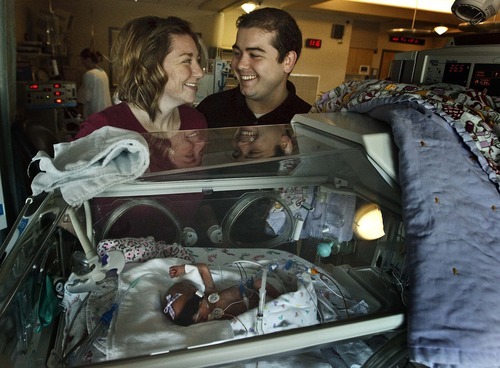This is an archived article that was published on sltrib.com in 2012, and information in the article may be outdated. It is provided only for personal research purposes and may not be reprinted.
The economy may be showing signs of recovery but the stork is still delivering fewer babies to Utah families, according to Utah hospitals.
The official 2011 tally from state health officials is not yet available. But three major hospital chains — which together welcome most of Utah's babies — say their delivery numbers remained flat or continued to drop.
Utah, long home to the nation's highest fertility rate, reached its zenith in 2008 with 55,605 newborns. But statewide births have slowed every year since then, with 52,164 counted in 2010.
The drop has widely been attributed, at least in part, to the lingering impact of the recession.
"Some patients in Utah will have a baby every two years," said Howard Sharp, a physician and division chief for obstetrics and gynecology at the University of Utah School of Medicine. "I definitely have heard patients say, 'We're going to wait three years or four years.' "
After a slight uptick between 2009 and 2010, births at University Hospital dropped from 3,452 in 2010 to 3,230 in 2011.
Marjean Stringer, 30, gave birth to Madison, her second daughter, this week at St. Mark's Hospital, owned by MountainStar Healthcare. She and her husband had delayed starting a family until he was done with law school.
The shaky economy definitely played a role in the parents' preparations this time.
"We did watch our money a lot more carefully," said Stringer, a former social worker who is now a stay-at-home mom. "I'd say it was careful planning on our part."
MountainStar delivered 8,933 babies in 2011, slightly down from 2010. Mark Meadows, vice president of development, said with the recession ending, he believes birth numbers will surge again.
"Utah's always had a high birth rate, and it probably always will," he said.
Growth in the southern end of Salt Lake County — particularly the number of young families — played a role in the company's decision to build Lone Peak Hospital, he said, which will open in 2013 in Draper.
"If you've got a delivery, you've got an emergency," he said. "You don't want to drive very far."
The number of babies born at Intermountain Healthcare hospitals stayed essentially flat, from 30,869 in 2010 to 30,286 in 2011.
But baby-making may be on an upward swing, according to Becky Simons, a nursing manager at Intermountain's McKay-Dee Hospital in Ogden.
Northern Utah families may no longer be delaying having children until the economy improves, she said.
"I heard a lot of talk about that several years ago," she said. "I've had friends who have waited, and they're deciding the time is right now."
Natalie Zundel's triplets will be among the babies counted in the 2012 Utah tally. The 29-year-old and her husband, an electrical engineer, had a daughter and were hoping for a second child, but ended up with three after she took a fertility drug.
"Now, of course, multiples with the economy is going to be a struggle," said Zundel, a former third-grade teacher. Her three new daughters were born at nearly 28 weeks at McKay-Dee this week. "Triplets — you never really plan on that."
Utah 2010 babies
Utah moms consistently produce more boys than girls with 26,837 boys born in 2010 versus 25,327 females. June was the most popular month to give birth.



